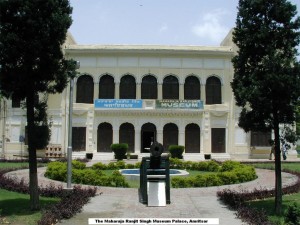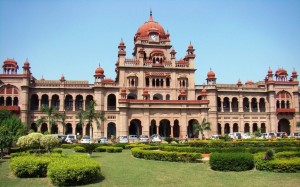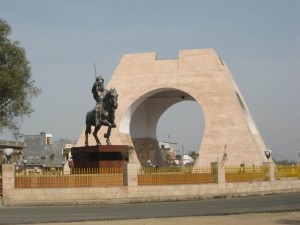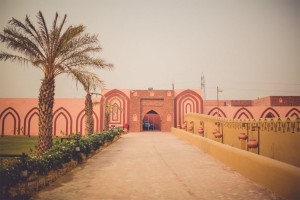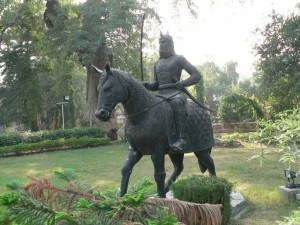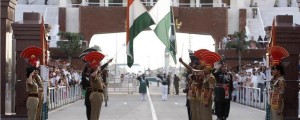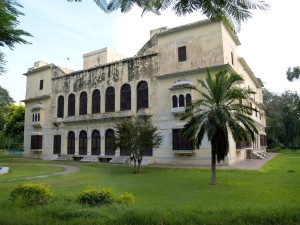- hotelpalaceamritsar@gmail.com
- +91-1832565111, 2563679, 9855911543
Sight Seeing
GOLDEN TEMPLE
|
“Amritsar is one of Punjab’s principal cities, dating back in history over 400 years. It is known more for the world famous Golden Temple, the seat of Sikh religion.” Situated on the north-western border of India, the city is also gateway for the travelers on the overland route through Pakistan. The Wagah border, which is the check-post is about 29 kms away. Amritsar literally means “the pool of nectar”, the name derived from a pool constructed at the sacred site in the 16th century. |
|
MAHARAJA RANJIT SINGH MUSEUM
|
The Ram Bagh Palace was converted into a museum in 1977 and has an interesting collection of archival records from the court of Maharaja Ranjit Singh, including the attire worn by Sikh warriors, paintings, miniatures, coins, and weapons. In close proximity of the museum lies the Maharaja Ranjit Singh Panorama, a permanent visual documentation of the Maharaja’s life. This remarkable feature is housed in a large two-storied circular building and features a magnificent painting depicting six of his major battles on the upper level. | |
DURGIANA TEMPLE
|
The 16th century Durgiana Temple draws Hindu sages and scholars from all over the country as it is a well known repository of Hindu scriptures. Dedicated to goddess Durga, the temple is modelled on the Golden Temple with its main shrine rising from the midst of a tank, its central dome covered with gold, and the rest of the structure clad in marble. Also known as the Lakshmi Narayan Temple, as a large section of it is dedicated to the Hindu deities Laxmi and Narayan, the intricate carvings of goddess Durga in her various incarnations, are particularly remarkable. The Durgiana temple was rebuilt in the 20th century, and its foundation stone was laid by the freedom fighter Pandit Madan Mohan Malviya, who was also an educationist and founded the Benaras Hindu University. | |
GOBINDGARH FORT
|
The foundation of the Gobindgarh Fort was laid in the mid 18th century by the leader of the Bhangi misl (clan). The imposing brick and lime structure, though locally known as the Bhangian Da Kila, derives its formal name from Guru Gobind Singh. Historically, possession of the fort was considered akin to possessing power over Punjab’s religious and political centres. It fell into Maharaja Ranjit Singh’s hands in the early 19th century during his expansionist missions. He further strengthened the walls of the fort and built a moat around it, adding several strong bastions to the structure. |
|
KHALSA COLLEGE
|
Khalsa College is an historic educational institution in the northern Indian city of Amritsar in the state of Punjab, India. Founded in 1892, the sprawling 300-acre (1.2 km2) campus is located about eight kilometers from the city-center on the Amritsar-Lahore highway (part of the Grand Trunk Road), adjoining Guru Nanak Dev University campus, to which Khalsa College is academically affiliated. |
|
GURU NANAK DEV UNIVERSITY
|
Guru Nanak Dev University was established at Amritsar, India on November 24, 1969 to commemorate Guru Nanak Dev’s birth quincentenary celebrations. Guru Nanak Dev University campus is spread over 500 acres (2 km²) near village of Kot Khalsa, nearly 8 km west of the Amritsar City on Amritsar – Lahore highway, next to Khalsa College, Amritsar. Recently, Guru Nanak Dev University has attained the highest status of University with Potential for Excellence (UPE) by the University Grants Commission (UGC). | |
INDIA GATE/WAR MEMORIAL
|
Punjab is the sword arm of the country and has been on the invasion route to the heart land of India since, the beginning of the recorded history. It is an amazing reality that the heroic people of this land across gender have never reneged on their duty towards the Idea of India in terms of living and dying by the military ethos of ‘Naam, Namak, Nishan’ (Honour, Integrity, Flag) always and every time there has been a call for duty.With this in view, Hon’ble Chief Minister Punjab Sardar Parkash Singh Badal decided that there was requirement for a world class memorial-cum-museum to come up at Amritsar, which as is commonly known is battle field associated with wars fought on its sacred soil since the times of Alexander the Great in 326 BCE. The project covers the heroism and sacrifices on the sacred soil of Punjab from the days Alexander the Great up to the Kargil War and the ongoing proxy war. It also covers the origins of Miri Piri which evolved at the time of the sixth Guru, Guru Hargobind Singh ji. | |
RAM TIRATH TEMPLE
|
Ram Tirath is believed to have been the ashram of Maharishi Valmiki, the composer of the epic Ramayana. Legend also has it that Lord Rama’s wife, Sita, gave birth to her twin sons, Luv and Kush, here. A hut that marks the site of their birth, and beautifully sculpted statues depicting scenes from the ancient Sanskrit epic are amongst the notable attractions. A four-day fair is held here every November. | |
SADDA PIND
|
Though Sadda Pind is a showcase of Punjab, there is nothing museum like or uninteresting about it. Each attraction here has been carefully chosen and planned keeping in mind your age and interests. Sadda Pind is a great place to visit with your family, friends or even colleagues. You can spend a day here, and even stay with us. Sadda Pind is a Punjabi Village resort spread across 12 acres of land. It brings you a chance to experience authentic culture, colours and flavours of Punjab in one place. Situated in the holy city of Amritsar, just 8 KM from Golden Temple and 7 KM from Airport, Sadda Pind offers a perfect setting for a weekend getaway or a short stay with family and friends. The people behind Sadda Pind have over 29 years of experience in hospitality and administration. Sadda Pind is an endeavour to redefine entertainment and hospitality through commitment and world class service. |
|
COMPANY BAGH
|
It is used to be the summer palace of Maharaja Ranjit Singh (1780-1839) in the past. The garden is built in the model of Shalimar gardens in Lahore.The garden has a panorama of the Maharaja Ranjit Singh, which is the joint venture of The National Council of Science and Museums and the State Government of Punjab. This panorama depicts the important events in the life of the Great Maharaja through three-dimensional montages. | |
WAGAH BORDER
|
As you move around this small but beautiful village, there is a lot that catches your eye. It’s as if this place was laid out with tourism in mind. There has been growing awareness about this border recently for its preserved heritage and geographical relevance. Attari Wagah Border has a great chronological importance for Punjab state where the tourism department has taken up the challenge to enhance tourism here by offer better facilities for tourists who come here to attend a retreat ceremony of the Indian Army. On a daily basis, this small village of Amritsar strains to accommodate around 18000 tourists for retreat ceremonies of the Indian Army. | |
RAM BAGH
|
The Ram Bagh Palace is set amidst gardens modelled on the famed Shalimar Gardens of Lahore. Named in honour of Guru Ram Das, it boasts rare plants and trees, water channels, and a well-appointed statue of Maharaja Ranjit Singh seated on a horse. Amidst this peaceful verdure, Maharaja Ranjit Singh had himself built a double-storied luxurious summer palace, with remarkably cool underground apartments for use in hot heather, in the early Indo-Sarcanic style. | |
JALLIANWALA BAGH
|
On 13 April 1919, a peaceful crowd of 2000 men, women and children had gathered in Jallianwala Bagh, a walled garden near the Golden Temple, to protest British rule. A group of British soldiers led by Brigadier-General Reginald Dyer opened unprovoked fire at the innocent crowd, relentlessly massacring the protestors even as the crowd dispersed in panic, many of them jumping into a well to escape the gunfire. Today, the furthest end of the Bagh is marked by a Martyrs’ Memorial built in the shape of an eternal flame. A section of the wall, pock-marked by bullets, as also the well, has been preserved as a reminder of the tragic event.
Indian history has gone through few most tragic incidents. There are some events which became headlines and it’s impossible to keep them out of our mind. Jallianwala Bagh amritsar incident is one of the most heart-rending chapters in the history of Amritsar. On April 13, 1919, when people of Amritsar gathered up to celebrate the festival of Baisakhi in Jallian wala bagh, they became the target of British army where the officer General Dyer gave shooting instruction to his army to kill the unarmed men, women and innocent children. The day turned into country’s saddest tragedy. It’s almost a century now, but the bullet marks can still be seen when you visit Jallianwala Bagh with Hop on Hop Off Amritsar. The place has now become a one of the most intriguing Sightseeing in Amritsar. |


